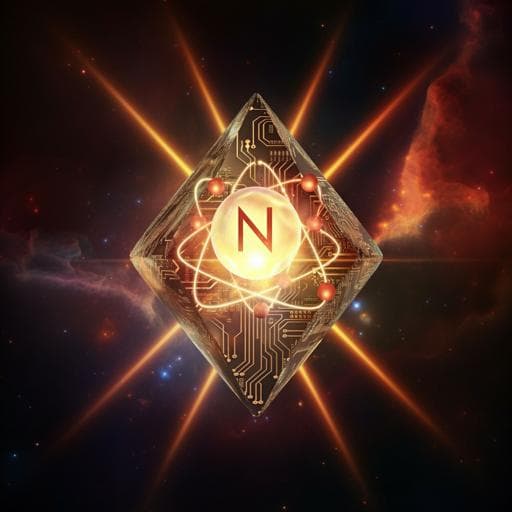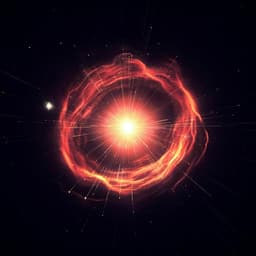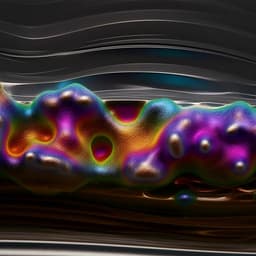
Physics
Room-temperature control and electrical readout of individual nitrogen-vacancy nuclear spins
M. Gulka, D. Wirtitsch, et al.
Unlock the potential of quantum technologies with room-temperature control and photoelectric readout of a single 14N nuclear spin, coupled to an NV electron. This groundbreaking research by Michal Gulka, Daniel Wirtitsch, and others paves the way for scalable electronic quantum processors.
~3 min • Beginner • English
Introduction
The study addresses the challenge of building a scalable, room-temperature quantum technology platform based on spin qubits in semiconductors, focusing on nitrogen-vacancy (NV) centers in diamond. While superconducting circuits and trapped ions have advanced, semiconductor spin systems offer scalability and integration. Nuclear spins provide long coherence times and have been used for quantum memories and early algorithms. In NV centers, high-fidelity electron and nuclear spin gates and error correction have been demonstrated, and large nuclear registers can be controlled via a single NV electron spin. Photon-mediated entanglement between distant NV electron spins has been shown at cryogenic temperatures but remains probabilistic with limited rates (~40 Hz), posing scalability issues. The purpose of this work is to demonstrate at room temperature an electrically read electron–nuclear spin gate approach using a diamond electronic chip, leveraging photoelectric detection of magnetic resonance (PDMR) to overcome optical diffraction-limited readout and enable nanoscale, electrode-limited spatial resolution. The authors aim to electrically read and coherently control a single intrinsic 14N nuclear spin via the NV electron near the excited-state level anti-crossing (ESLAC), and to develop a theoretical framework for photoelectric readout and gate operations, advancing towards scalable, electrically read diamond quantum devices.
Literature Review
Prior works established NV centers as robust solid-state qubits with high-fidelity single- and two-qubit gates and demonstrated quantum error correction in hybrid spin registers. Nuclear spins (13C, 14N/15N) around NVs can form large registers, with control of up to 27 nuclear spins via one NV electron. Photon-mediated entanglement between distant NV nodes has been achieved but is probabilistic and operated at low temperatures, with limited entanglement rates (~40 Hz). Photoelectric detection of NV spin resonance (PDMR) has been developed, enabling electrical readout of single NV electron spins and offering advantages over optical detection, such as no excited-state saturation and potentially higher detection rates due to longer carrier lifetimes and high collection efficiency. Electrical detection of large ensembles using EDENDOR has been reported, but single nuclear spin electrical readout remained unachieved. Advances in NV creation via co-doping and deterministic implantation at nanometer precision suggest potential for scalable arrays readable via electrodes at nanoscale. These works motivate an electrically readable, room-temperature approach to individual nuclear spin detection and control using PDMR near ESLAC.
Methodology
Experimental platform: A commercial IIa HPHT diamond (electronic-grade [111], <10 ppb N) with intrinsic single NV defects was used. Interdigitated coplanar electrodes (3.5 µm gap; 20 nm Ti / 100 nm Al) and a microwave (MW) line were fabricated by optical lithography and wire-bonded to a PCB. A bias of ~8.6 V (electric field ~2.5 × 10^4 V/cm) was applied to collect photo-generated carriers. Photocurrent was preamplified (Stanford SR570, ×10^12) and measured with lock-in detection (SR850), using a low-frequency (7 Hz) envelope to trigger readout.
Optical excitation and imaging: A 561 nm CW laser (4–6 mW before objective) was pulsed by an acousto-optic modulator and focused using a 40×, NA 0.95 air objective. Yellow-green 561 nm light was chosen to suppress photoionization of substitutional nitrogen (P1 centers) compared to 532 nm. Simultaneous optical and electrical scans localized single NVs (~2.5 µm deep); due to two-photon NV− ionization and Gaussian focusing, electrical imaging provided higher spatial resolution (notably a threefold reduction of axial FWHM) and higher contrast compared to photoluminescence.
PDMR operating principle near ESLAC: Near B ≈ 510 G aligned with the NV axis, excited-state spin mixing and intersystem crossing polarize the electron spin to ms=0 and the 14N nuclear spin to mI=+1 (>98% polarization). Spin-dependent two-photon ionization of NV− to the conduction band and charge-state conversion to NV0 generate electron and hole currents collected by electrodes. Back-conversion NV0→NV− occurs via a two-photon process, preserving nuclear spin orientation. A pulsed lock-in envelope readout scheme applied laser pulses during the high state of a low-frequency envelope while MW pulses were continuous; the envelope’s rising edge triggered the lock-in.
Spin control and readout sequences: Nuclear RF pulses (few MHz) and MW π-pulses were applied to drive specific transitions. For MW-assisted nuclear readout, the sequence included: laser polarization/readout (e.g., 4 µs, 6 mW), RF pulse to rotate nuclear spin (mI=−1→0), and a selective MW π-pulse (400 ns) swapping electron ms=0↔−1 on the chosen hyperfine branch, enabling nuclear-state-dependent photocurrent contrast. Nuclear resonance was measured by sweeping RF frequency with π-pulses; Rabi oscillations were obtained by varying RF pulse duration. A MW-free variant omitted MW pulses and relied on ESLAC-induced spin mixing and reverse electron repolarization via the nuclear spin to obtain contrast.
Modeling: A Lindblad master-equation model was developed including five electronic manifolds (NV− ground and excited triplets, singlet shelving state; NV0 ground and excited states). Thirteen Lindblad operators modeled non-unitary transitions (rates from literature/Supplementary). The spin Hamiltonian included electron, nuclear, and hyperfine interactions in NV− ground and excited states, with zero-field splittings (D_ES=1.42 GHz), hyperfine tensors (A∥=27.45 MHz, A⊥=41.42 MHz in ES), and nuclear quadrupole P=−5.01 MHz; ms ∈ {0, −1} considered. Photon emission rates and electron/hole currents were computed from time-dependent populations and transition rates, enabling comparison of ODMR and PDMR contrasts versus laser power and integration time. Time-resolved PL traces starting from prepared spin states (via RF and MW π-pulses) validated the model and elucidated charge dynamics.
Data acquisition considerations: Due to limitations of current preamplifiers (insufficient >10 MHz gating with high gain at room temperature), photocurrent was integrated over entire laser pulses and sequences, reducing maximum spin contrast compared to short-window optical detection. A low-frequency envelope modulation was used to filter DC noise and enhance SNR for long nuclear manipulation sequences. Frequent refocusing mitigated sample drift impacting electrical signal due to high spatial selectivity.
Key Findings
- Demonstrated photoelectrical detection and coherent control of a single intrinsic 14N nuclear spin in an individual NV center at room temperature using PDMR near the ESLAC.
- Electrical imaging of a single NV achieved improved spatial resolution over optical imaging, including approximately threefold reduction of the axial FWHM; higher imaging contrast observed due to two-photon ionization.
- Device performance: Interdigitated electrodes with 3.5 µm gap; optimal bias at 8.6 V yielded signal-to-background contrast (SBC) >65% for the NV photocurrent. 561 nm excitation at 4–6 mW increased NV-generated photocurrent without saturation; higher laser power requires shorter readout pulses to maintain magnetic resonance contrast.
- Hyperfine-resolved PDMR spectra were recorded close to ESLAC at magnetic fields including 123 G and 439 G with clear nuclear (14N) and electron hyperfine features under pulsed conditions (e.g., 1500 ns laser at 4 mW with 1100 ns MW π at 123 G; 1000 ns laser at 6 mW with 400 ns MW π at 439 G).
- Near 439–500 G, nuclear spin polarization to mI=+1 exceeded 98%, enabling direct nuclear control and readout via the electron ancilla.
- Coherent nuclear control: Electrically detected 14N nuclear RF resonances and Rabi oscillations were observed with high contrast. Nuclear PDMR contrast was close to 5% with 4 µs, 6 mW laser readout pulses. Rabi nutations maintained high contrast for RF durations up to 140 µs. Depending on RF duration, operations correspond to an entangling CNOT gate with maximal entanglement at π/2 (~18 µs).
- MW-free nuclear readout: By exploiting spin mixing near ESLAC, omitting MW pulses still yielded nuclear resonances and Rabi oscillations with contrast similar to MW-assisted readout, indicating efficient reverse electron repolarization by the nuclear spin and enabling low-jitter, simpler gate protocols.
- Modeling insights: The Lindblad model reproduced time-resolved PL from different initial spin states and predicted electron and hole current dynamics. Electron current time dependence closely followed PL; hole currents contributed to sustained PDMR contrast over longer integration times. Predicted contrasts showed larger ODMR than PDMR at 1 mW and comparable contrasts at 3 mW, aligning qualitatively with experiments. Deviations likely arise from environmental factors (traps, recombination centers) affecting charge transport; nonlinear recombination at high power can enhance PDMR contrast.
- Practical readout characteristics: Due to integration over entire pulses (limited by current electronics), maximum spin contrast is reduced as spins initialize within ~0.5 µs. Nonetheless, PDMR maintains contrast over prolonged sequences, aided by hole current contributions and slower nuclear polarization for mI=0,−1 at ESLAC (2×–3× longer than mI=+1), and by low-noise electrode architecture with lock-in detection.
Discussion
The findings establish, for the first time, room-temperature photoelectrical detection and coherent control of an individual nuclear spin in diamond, using an NV electron as an ancilla and ESLAC-enabled polarization and mixing. This directly addresses scalability challenges by providing an electrical, electrode-defined readout pathway that bypasses optical diffraction limits and is compatible with nanoscale electronics. The demonstrated nuclear control and both MW-assisted and MW-free readout validate the feasibility of two-qubit electron–nuclear gates and readout with significant contrast even during long manipulation sequences, key for nuclear-spin-based memories and processors. The theoretical Lindblad framework accurately captures coupled spin–charge dynamics and informs optimization of PDMR versus ODMR under varying powers and integration times, highlighting the role of electron and hole contributions and environmental charge traps. These results support the development of site-selective, electrically readable qubit nodes at nanoscopic distances suitable for dipolar coupling, advancing towards scalable electronic quantum processors and sensors. Remaining challenges include engineering site-selective electron spin polarization at short distances (e.g., via Stark-tuned resonant addressing and charge-state control with nanoscale electrodes) and implementing magnetic gradients for nanoscale frequency encoding.
Conclusion
This work demonstrates room-temperature electrical readout and coherent control of a single 14N nuclear spin in an NV center via PDMR near the ESLAC, achieving hyperfine-resolved spectra, nuclear Rabi oscillations up to 140 µs, and comparable contrast with MW-assisted and MW-free protocols. Electrical imaging provides superior spatial resolution and high contrast, and device-level readout is defined by electrode geometry rather than optical diffraction. A comprehensive Lindblad model describes the coupled spin and charge-state dynamics and guides optimization of PDMR. These advances constitute a key step towards electrically readable, scalable diamond quantum devices based on closely spaced, dipolarly coupled spin qubits. Future work should focus on site-selective electron spin polarization at nanoscopic separations (Stark-shift-based resonant control, charge-state engineering), integration of nearby 13C nuclear registers, improved material/device engineering to control traps and recombination, and development of fast, low-noise current preamplifiers to enable time-gated photocurrent readout with higher spin contrast.
Limitations
- Current photocurrent detection electronics lack fast high-gain gating (>10 MHz with ~10^12 gain) at room temperature, necessitating integration over entire laser pulses and sequences, which reduces maximum spin contrast compared to short-window optical detection.
- Experimental deviations from the isolated NV model contrasts likely stem from environmental effects such as charge traps and recombination centers that differentially affect electron and hole currents, particularly at higher laser powers; material/device-dependent nonlinear recombination can alter PDMR contrast.
- Background currents (dark and non-NV photocurrent, e.g., from P1 centers) and sample drift can impact SNR; frequent refocusing was required due to the high spatial selectivity of electrical detection.
- Nuclear polarization and contrast depend on precise magnetic field alignment near ESLAC (~510 G), which may limit robustness; although strong contrast was observed also around 439–500 G, operation windows are constrained.
- Entangling gate performance (fidelity, error rates) was not characterized; integration into larger multi-qubit arrays will require site-selective addressing and mitigation of cross-talk.
Related Publications
Explore these studies to deepen your understanding of the subject.







